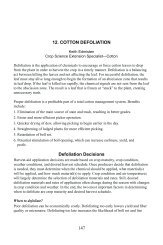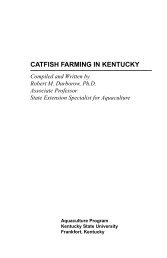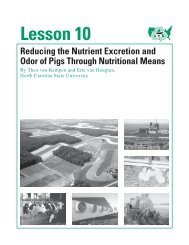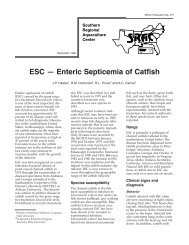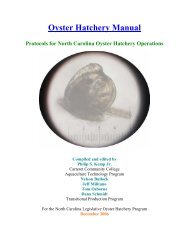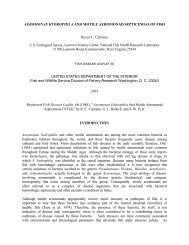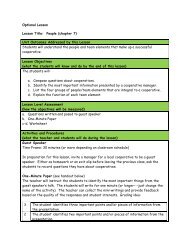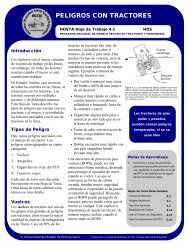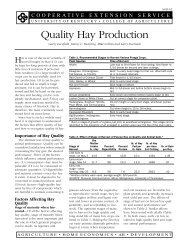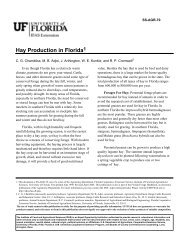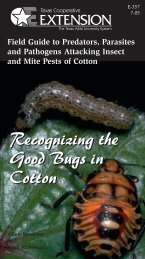Dryland Pastures in Montana and Wyoming - MSU Extension
Dryland Pastures in Montana and Wyoming - MSU Extension
Dryland Pastures in Montana and Wyoming - MSU Extension
Create successful ePaper yourself
Turn your PDF publications into a flip-book with our unique Google optimized e-Paper software.
spread of noxious weeds. <strong>Dryl<strong>and</strong></strong> pastures should be <strong>in</strong>spected annually, <strong>and</strong> any<br />
noxious weed <strong>in</strong>festations should be controlled by graz<strong>in</strong>g or by us<strong>in</strong>g appropriate<br />
herbicides. Elim<strong>in</strong>at<strong>in</strong>g or reduc<strong>in</strong>g small, isolated weed <strong>in</strong>festations is much more<br />
cost-effective than attempt<strong>in</strong>g to control widespread weed <strong>in</strong>festations. Be sure to<br />
follow pesticide label <strong>in</strong>structions for rates, safety <strong>and</strong> re-entry period for graz<strong>in</strong>g<br />
livestock.<br />
Good dryl<strong>and</strong> pasture management is a major component of <strong>in</strong>tegrated weed<br />
management, <strong>and</strong> there is currently much research be<strong>in</strong>g conducted on this subject.<br />
In terms of noxious weed management, some of the perceived “cost-prohibitive”<br />
strategies of reseed<strong>in</strong>g, new fenc<strong>in</strong>g, water development, tillage, fertilization,<br />
etc. may <strong>in</strong> fact become very cost-effective if they improve a dryl<strong>and</strong> pasture so<br />
that it becomes more resistant to noxious weed <strong>in</strong>vasion. <strong>Dryl<strong>and</strong></strong> pastures are major<br />
assets for ranchers <strong>in</strong> <strong>Montana</strong> <strong>and</strong> Wyom<strong>in</strong>g. Producers should manage their<br />
improved dryl<strong>and</strong> pastures to optimize profitability <strong>and</strong> long-term susta<strong>in</strong>ability.<br />
Graz<strong>in</strong>g Management<br />
Well-managed livestock graz<strong>in</strong>g will extend the productive life of dryl<strong>and</strong><br />
seeded pastures <strong>and</strong> improve their economic returns. Seeded pastures should be<br />
fenced separately from native rangel<strong>and</strong>, <strong>and</strong> seed<strong>in</strong>gs of different species or mixtures<br />
should also be fenced separately from each other. This is advisable because of<br />
the differences <strong>in</strong> maturity, palatability <strong>and</strong> graz<strong>in</strong>g tolerance among plant species.<br />
Separate pastures enable the plants to be grazed when they are most palatable <strong>and</strong><br />
nutritious, or when their use best complements the other forage resources of a<br />
ranch.<br />
Tim<strong>in</strong>g of Graz<strong>in</strong>g<br />
New seed<strong>in</strong>gs must be protected from graz<strong>in</strong>g until they are well established.<br />
Generally, graz<strong>in</strong>g should be deferred at least until the first seed crop has matured.<br />
It may be necessary for the non-use period to exceed one year if seedl<strong>in</strong>g establishment<br />
was slow due to poor weather, weeds or other factors.<br />
Plant height is a good <strong>in</strong>dicator of when a seeded pasture is ready for graz<strong>in</strong>g<br />
<strong>and</strong> when livestock should be removed (Figure 3). Most species that are commonly<br />
seeded for dryl<strong>and</strong> pasture are ready for graz<strong>in</strong>g when plants reach 6-8 <strong>in</strong>ches high<br />
<strong>and</strong> graz<strong>in</strong>g should cease when 3-4 <strong>in</strong>ches of plant height rema<strong>in</strong>s. Bas<strong>in</strong> wildrye is<br />
one exception—graz<strong>in</strong>g should not beg<strong>in</strong> until plants reach 11-12 <strong>in</strong>ches high <strong>and</strong><br />
graz<strong>in</strong>g should cease when 8 <strong>in</strong>ches of plant height rema<strong>in</strong>s. The time it takes for<br />
plants to regrow <strong>and</strong> recover before they can be grazed aga<strong>in</strong> depends on the plant<br />
species, weather <strong>and</strong> soil fertility. Also, plants with abundant leaves rema<strong>in</strong><strong>in</strong>g after<br />
graz<strong>in</strong>g will recover more quickly than closely grazed plants. A m<strong>in</strong>imum recovery<br />
period of 21-30 days is usually needed when grow<strong>in</strong>g conditions are optimal <strong>in</strong><br />
spr<strong>in</strong>g. Recovery periods of two to three months may be required after graz<strong>in</strong>g <strong>in</strong><br />
summer or early fall.<br />
— 19 —




